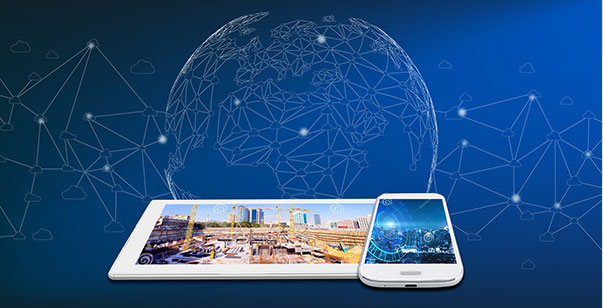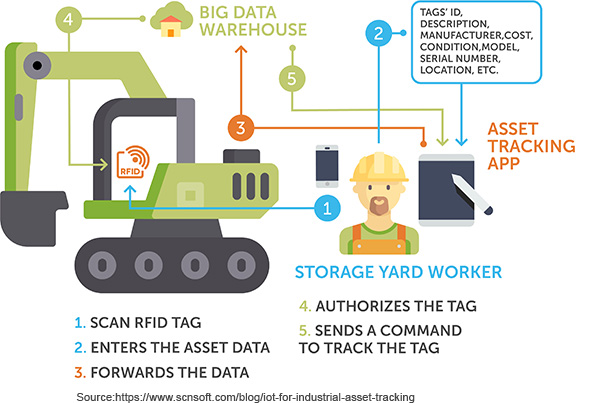
Improving Facility Management Efficiency Integrating BIM, IoT, and Scan-to-CAD
Facility Management in the Construction Industry
Throughout the world, the term facility means something that is built, installed or established to serve a purpose, which, in general, is every tangible asset that supports an organization. Examples are real estate property, buildings, infrastructure, transportation, heating, ventilation, and air-conditioning (HVAC) systems, lighting, internet technology, security, furniture, and other user-specific systems, equipment, and appliances. The European standard (BS EN 15221-5:2011) for facility management defines it as “the integration of processes within an organization that maintains and develops the agreed services that support and improve the effectiveness of its primary activities.”
Facility management is a profession concerned with the efficient management of facilities in the built environment at both a strategic and a day-to-day level to deliver operational objectives and maintain a safe, efficient environment. It encompasses multiple disciplines to ensure functionality of the built environment through the integration of people, place, process, and technology.
While there has always been a need for facility management as a construction management service, it has recently emerged, developed and grown as an independent profession. This is the result of the increasing rate of change required in the built environment, the trend for outsourcing services, and the introduction of procurement routes that include operation and maintenance in integrated supply contracts.
AutoCAD managed computer-aided facility management has a lot of flexibility, such as specifying occupancy data in CAFM drawings, setting up drawings, and exporting the information into Excel, etc. However, facility management services can be efficiently provided either by in-house facility management departments, specialist facility management contractors, managing agents, multi-service companies or special purpose vehicles.
What Benefit Facility Management Brings to the AEC Sector
Construction management enables AEC stakeholders to manage, coordinate, and supervise the construction process from inception through ‘project completion and beyond’ on timely and economic bases. It is the ‘project completion and beyond’ phase that is of interest to those involved in facilities management, although their earlier involvement is becoming more necessary.
An efficient facilities management system delivers an end-to-end solution for managing the business operations of a built asset. It aims to improve organization efficiency in its core business activities and takes care of all facility management requirements. An integrated facility management solution drives an organization with actionable data points to improve an organization. This not only drives down operational costs but also improves return on investment on assets by minimizing risks, reducing capital expenses, improving operational and maintenance scheduling and meeting regulatory requirements.

Challenges to Achieving Efficient Facility Management
Despite the promise of what facility management can deliver, during their work, facility managers face multiple productivity challenges in optimizing asset performance in an ever-expanding sector. They are forced to do more with less, which is onerous for organizations with multiple facilities. With a stock of distributed asset and individual requirements, their day-to-day operational challenges are amplified.
Cost Management
Every demand placed on a facility has an associated cost. From staff hiring, through to maintenance and repair, inventory and supplies, safety and security, achieving cost reduction across multiple areas without reducing quality is complicated.
Asset Maintenance
Much equipment in use today is at leasta decade old. The risk of running unsafe equipment cannot be over-emphasized. Maintenance costs can be significant, and asset maintenance is a complex process requiring rigorous information flow and fast response.
Security Management
Security management assures the protection of life and property against unforeseen damage or theft through access control, surveillance, intelligence, deterrent, investigation, incident management, risk management, and loss control. It is a specialist field, and without a security management plan in place, it is a challenge to reduce security incidents, safety cases, damages reports, increase productivity, provide a secure workplace and maintain company reputation.
Inventory Management
Most FM operations are faced with the challenge of keeping an up to date equipment inventory. Without access to a centralized digital information platform, where inventory reports can be checked, facility managers can become inefficient. BIM 360 document management comes to rescue with management of blueprints, 2D drawings, 3D BIM models, and any other project documents.
Time Management
Facility managers perform many daily tasks, whether coordinating teams, attending meetings, answering emails, consulting vendors or suppliers and more. Without having facilities management information stored electronically, in the cloud to automatically answer frequent questions and to establish priorities, facility managers’ time will be lost.
Stakeholder Coordination
Workplace practices need to be collaborative and foster constant communication, organization, knowledge-sharing, productivity, and innovation. Without a mobile, a web-based FM solution and the use of digital calendars, that allow facilities management teams to report failures, generate automated reports, check equipment history and more, operational tasks are labor-intensive.
Change Management
Understanding the processes behind applying for design and building approvals and maintaining standards and environmental requirements can be complex and achieving approval difficult. There is also a need to understand regulatory or standard changes in advance, and to be clear about what applies in any given area. Without a clear change management process in place, achieving compliance is a challenge.
How BIM, IoT, and CAD Contribute Toward Improving Facility Management
Here we reveal how facilities management can be improved beyond the use of Computer Aided Facility Management (CAFM) solutions and CMMS through the integration of BIM, the Internet of Things (IoT) and Scan-to-BIM.
How Facility Management Challenges Can be Overcome by Adopting BIM
The benefits of BIM construction management can be leveraged beyond design and construction for effective management of the operation and maintenance of a facility during the occupation. Through what is known as the 7th dimension (7D) BIM, facility management can be rendered more efficient. The features of 7D BIM can be explained further as follows:

Real-time change management
All built assets undergo multiple changes through all stages of their lifecycle. All changes can be recorded, often in real-time, in an as-built digital BIM model and linked to CAFM software to facilitate the current or future management, repair or renovation, of a built asset once occupied.
Comprehensive information
A BIM model can be loaded with graphical and non-graphical information of a building. Information, the ‘I’ of a BIM model, is critical, and facility managers can also use it to define and achieve energy efficiency goals. Information duplication is avoided, leading to faster execution and cost savings.
Improved coordination
BIM is useful to facility managers for repair or renovation work as all MEP, and structural information can be stored within it, enabling work to become more collaborative and safer with reduced risk of errors, omissions or inaccuracies.
Enhanced performance and maintenance
An effective facility maintenance plan can be prepared by BIM experts integrating BIM with a CMMS to improve efficiency. This can improve project predictability and enable facility managers to be involved during the design phase of a project.
Improved Safety Management
Safety certified engineers can conduct hazard and risk control reviews of aging facilities management equipment.
How Facility Management Challenges can be Overcome through IoT
The Internet of Things (IoT) enables new possibilities for built asset integration and the evolution of intelligent buildings. IoT makes it easy to manage FM operations in an automated building environment. Associated analytics capability allows facility managers to understand current performance and observe trends within facilities and building automation systems (BMS) at any time.

Cloud-based environment
Multiple data points can be combined in the cloud and models applied to influence outcomes. IoT uses a common Internet Protocol (IP) platform to automatically connect building sensors and devices, exchange and analyze information and optimize controls. FM solutions can be equipped with mobile, state-of-the-art technology and remote wireless communications for live monitoring and control of HVAC, lighting, and energy metering devices across all locations and visualization dashboards allow performance metrics, graphs, charts, and power-to-cost conversions to be provided.

Supply management, replenishment, space allocation and procurement
Supply management, equipment replenishment, space allocation, and procurement activities can all be coordinated with a facility management solution. Notification alerts can be configured to ensure that critical items are always in supply. Space allocation for a facility is made after assessing long-term and short-term needs. Facility management planning includes space projection, space utilization, and occupancy details. Vacant and unutilized space can be marked for consolidation.

Remote tracking and usage monitoring
A facility management solution can be used to track (categorize, tag and collect), monitor and predict big data for all assets (such as construction tools and equipment usage, people through biometric cards or radio-frequency identification cards, or management activities) in an organization during all lifecycle management processes and provide status updates. Fire prevention, security, fuel, and health monitoring can be achieved, and discrepancies immediately indicated to facility managers. Sensors can be configured to communicate any suspicious or malicious activity and detect performance issues or failure in advance of catastrophic and costly repairs. Modules in a CMMS application track cost expenditures, including detailed historical analysis, to allow for proper administrative reporting.

Management, servicing, and repair
Facility management takes care of operations management (premise management and cleaning), lease renewal management, equipment management, audit and compliance management, service and repair contracts and other such concerns across multiple offices and sites. Business continuity and operational cost reduction is a high priority for most organizations, and efficient facility management processes enable this. Good systems have preconfigured checklists to ensure that requirements are met. Simple and intuitive mobile apps and solutions can be used to upload the status of work.

Energy Savings
HVAC and other systems can be optimized for energy savings without sacrificing occupant comfort. Upgrading to automated buildings technologies, such as solar panels, using more natural light, light emitting diode lighting, distributed energy resources can save energy. Dynamic data on energy consumption can be combined with other connected sensors and devices to help facility managers automatically adjust thermal comfort controls.
Augmented Reality
As it continues to grow, augmented reality (AR) provides enhanced ability to see operational instructions and other information overlaid onto the real-world view of the project. Thermal imaging AR technology, for example, can help identify hot spots within equipment and revolutionize predictive maintenance programs.
How Facility Management Challenges can be Overcome through Scan to CAD
Initiatives are transforming how buildings are being designed and constructed whether new construction and renovation projects on existing buildings throughout the world. Digital transformation is a key part in this. Fully digital Scan-to-BIM services replace hand-drawn manual surveys performed during facility management processes. They assist in enabling the following:

Planning and Design
In older facilities, a key issue is that those planning renovations or improvements cannot access good documentation or as-built drawings. This data can be used in multiple ways, but one of the quickest is to make it usable as a by-product of the scan – processed ‘point cloud’ data – available through a 3D viewer. This allows for 3D viewing of the scanned area as if a viewer was there. It also allows for dimensioning and ability to mark-up areas of concern for emailing to other stakeholders. Data can then be extracted and modeled in phases based on priorities. Final data can be presented in an AutoCAD project management format or even imported into a Geographic Information System (GIS).
Evaluation
Drawing and information can be saved and their data used for the future reference and evaluation, so certain components don’t have to be redesigned, information can be standardized and used whenever required in any future documentation.
Compliance (Safety and Regulatory)
Scanned data and information can be used for construction, safety training, calculations, documentation for regulatory purposes and even during the bidding process.
Cost and Schedule Reduction
It is not something out of the blue for mature CAFM users to get high operational savings of up to 5% of the facility budget. These savings occur when digital data is created early in the process and reused as often as possible. For example, if an organization creates CAD drawings for space planning and management purposes, the reuse of this graphics database for other applications (asset tracking, risk management, telecommunications and so on) becomes highly cost-effective.
An early 3D scan can act as a baseline in instances when changes caused by environmental conditions are a concern. By scheduling regular scans, operators can get the opportunity to monitor changes to determine if they are creating an unsafe environment. A reflective example of this would be monitoring a dynamic facility environment with a high number of moving parts.
BIM Implementation in Aquarium Hilton Garden Inn, Atlanta, Georgia
The $46 million, 484,000 sq.ft Aquarium Hilton Garden Inn project had not been initially designed using BIM, but the General Contractor led the project team to develop the MEP models of the proposed facility for:
- Initial visualization uses
- Clash detection analysis to identify potential collisions or clashes between various structural and mechanical systems.
- Various system installations
- Reflect as-built conditions provided the plan. a digital 3D model of the building and its various systems to help aid operation and maintenance procedure
The project realized some excellent benefits through the use of BIM and certainly exceeded the expectations of the owner and other project team members. More than 590 clashes were detected pre-construction.
There were significant cost benefits to the owner, and unknown costs were avoided through collaboration, visualization, understanding, and early identification of conflicts in addition to reported savings. Overall cost savings based on collisions detected throughout the project was estimated at roughly $801,500 and net adjusted cost savings just under $200,500.
How BIM did the Magic for Emory Psychology Building, Emory University, US
The $35 million Emory Psychology Building is an environmentally certified 110,000 sq.ft facility. The project architect developed BIM during the early design phase to:
- To determine the best building orientation
- To evaluate various skin options
- To perform daylight (shading and lighting studies and right-to-light) studies-shading and lighting studies: determined the effects of the sun throughout the year and the effects of the facility on surrounding buildings.
- Right-to-light studies: evaluated lighting conditions at the proposed facility’s courtyard space and those spaces adjacent to the courtyard.
Views of the facility were established within the BIM software using the software’s sun positioning feature.
As a result of these studies, the facility’s design was adjusted as follows:
- Window openings on the west façade reduced.
- Penthouse square footage reduced
- overall building height reduced.
All adjustments were able to be incorporated during the design phase, and analyses prevented costly and time-consuming redesign at later stages in the project life cycle.
BIM, IoT, CAD Influencing the Increase in Productivity Through Facility Management
The crucial role of facility management in increasing productivity was highlighted in a 2015 survey that marked World FM day. 61% of those surveyed said that workplace environment and facility service improvements have a positive effect. 30% claimed that facility management is helping to enhance social interactions among workers, 22% to improve worker efficiency in day-to-day tasks and 22% to improve worker well-being.
As has been shown in this article, facility managers can overcome their productivity challenges through BIM construction management, IoT and Scan-to-Cad – all measures that inextricably ease work processes for facility managers and workers.
-IndiaCADworks











